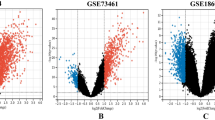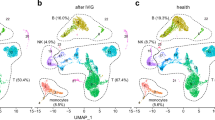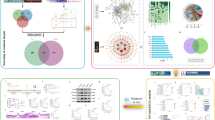Abstract
Background
Kawasaki disease (KD) is a systemic vasculitis that is currently the most common cause of acquired heart disease in children. However, its etiology remains unknown. Long non-coding RNAs (lncRNAs) contribute to the pathophysiology of various diseases. Few studies have reported the role of lncRNAs in KD inflammation; thus, we investigated the role of lncRNA in KD inflammation.
Methods
A total of 50 patients with KD (median age, 19 months; 29 males and 21 females) were enrolled. We conducted cap analysis gene expression sequencing to determine differentially expressed genes in monocytes of the peripheral blood of the subjects.
Results
About 21 candidate lncRNA transcripts were identified. The analyses of transcriptome and gene ontology revealed that the immune system was involved in KD. Among these genes, G0/G1 switch gene 2 (G0S2) and its antisense lncRNA, HSD11B1-AS1, were upregulated during the acute phase of KD (P < 0.0001 and <0.0001, respectively). Moreover, G0S2 increased when lipopolysaccharides induced inflammation in THP-1 monocytes, and silencing of G0S2 suppressed the expression of HSD11B1-AS1 and tumor necrosis factor-α.
Conclusions
This study uncovered the crucial role of lncRNAs in innate immunity in acute KD. LncRNA may be a novel target for the diagnosis of KD.
Impact
-
This study revealed the whole aspect of the gene expression profile of monocytes of patients with Kawasaki disease (KD) using cap analysis gene expression sequencing and identified KD-specific molecules: G0/G1 switch gene 2 (G0S2) and long non-coding RNA (lncRNA) HSD11B1-AS1.
-
We demonstrated that G0S2 and its antisense HSD11B1-AS1 were associated with inflammation of innate immunity in KD.
-
lncRNA may be a novel key target for the diagnosis of patients with KD.
Similar content being viewed by others

Log in or create a free account to read this content
Gain free access to this article, as well as selected content from this journal and more on nature.com
or
References
Newburger, J. W. et al. Diagnosis, treatment, and long-term management of Kawasaki disease: a statement for health professionals from the Committee on Rheumatic Fever, Endocarditis and Kawasaki Disease, Council on Cardiovascular Disease in the Young, American Heart Association. Circulation 110, 2747–2771 (2004).
Kawasaki, T. Acute febrile mucocutaneous syndrome with lymphoid involvement with specific desquamation of the fingers and toes in children. Arerugi 16, 178–222 (1967).
McCrindle, B. W. et al. Diagnosis, treatment, and long-term management of Kawasaki disease: a scientific statement for health professionals from the American Heart Association. Circulation 135, e927–e999 (2017).
Dietz, S. M. et al. Dissecting Kawasaki disease: a state-of-the-art review. Eur. J. Pediatr. 176, 995–1009 (2017).
Verdoni, L. et al. An outbreak of severe Kawasaki-like disease at the Italian epicentre of the SARS-CoV-2 epidemic: an observational cohort study. Lancet 395, 1771–1778 (2020).
Hara, T. et al. Kawasaki disease: a matter of innate immunity. Clin. Exp. Immunol. 186, 134–143 (2016).
Hirata, S., Nakamura, Y. & Yanagawa, H. Incidence rate of recurrent Kawasaki disease and related risk factors: from the results of nationwide surveys of Kawasaki disease in Japan. Acta Paediatr. 90, 40–44 (2001).
Ye, F. et al. Neutrophil-derived S100A12 is profoundly upregulated in the early stage of acute Kawasaki disease. Am. J. Cardiol. 94, 840–844 (2004).
Ebihara, T. et al. Differential gene expression of S100 protein family in leukocytes from patients with Kawasaki disease. Eur. J. Pediatr. 164, 427–431 (2005).
Guttman, M. et al. Chromatin signature reveals over a thousand highly conserved large non-coding RNAs in mammals. Nature 458, 223–227 (2009).
Zangrando, J. et al. Identification of candidate long non-coding RNAs in response to myocardial infarction. BMC Genomics 15, 460 (2014).
Wang, X. et al. Early expressed circulating long noncoding RNA CHAST is associated with cardiac contractile function in patients with acute myocardial infarction. Int. J. Cardiol. 302, 15–20 (2020).
Chen, S. et al. Comprehensive analysis and co-expression network of mRNAs and lncRNAs in pressure overload-induced heart failure. Front. Genet. 10, 1271 (2019).
Ouyang, F. et al. Long non-coding RNA RNF7 promotes the cardiac fibrosis in rat model via miR-543/THBS1 axis and TGFβ1 activation. Aging 12, 996–1010 (2020).
Ayusawa, M. et al. Revision of diagnostic guidelines for Kawasaki disease (the 5th revised edition). Pediatr. Int. 47, 232–234 (2005).
Li, H. & Durbin, R. Fast and accurate long-read alignment with Burrows-Wheeler transform. Bioinformatics 26, 589–595 (2010).
Kim, D., Langmead, B. & Salzberg, S. L. HISAT: a fast spliced aligner with low memory requirements. Nat. Methods 12, 357–360 (2015).
Ohmiya, H. et al. RECLU: a pipeline to discover reproducible transcriptional start sites and their alternative regulation using capped analysis of gene expression (CAGE). BMC Genomics 15, 269 (2014).
Robinson, M. D., McCarthy, D. J. & Smyth, G. K. edgeR: a Bioconductor package for differential expression analysis of digital gene expression data. Bioinformatics 26, 139–140 (2010).
Young, M. D., Wakefield, M. J., Smyth, G. K. & Oshlack, A. Gene ontology analysis for RNA-seq: accounting for selection bias. Genome Biol. 11, R14 (2010).
Russell, L. & Forsdyke, D. R. A human putative lymphocyte G0/G1 switch gene containing a CpG-rich island encodes a small basic protein with the potential to be phosphorylated. DNA Cell Biol. 10, 581–591 (1991).
Kobayashi, S. et al. Expression profiling of PBMC-based diagnostic gene markers isolated from vasculitis patients. DNA Res. 15, 253–265 (2008).
Jakobsson, P. J. Pain: how macrophages mediate inflammatory pain via ATP signaling. Nat. Rev. Rheumatol. 6, 679–681 (2010).
Kioka, H. et al. Evaluation of intramitochondrial ATP levels identifies G0/G1 switch gene 2 as a positive regulator of oxidative phosphorylation. Proc. Natl Acad. Sci. USA 111, 273–278 (2014).
Furukawa, S., Matsubara, T. & Yabuta, K. Mononuclear cell subsets and coronary artery lesions in Kawasaki disease. Arch. Dis. Child. 67, 706–708 (1992).
Luo, Y. et al. Up-regulation of miR-27a promotes monocyte-mediated inflammatory responses in Kawasaki disease by inhibiting function of B10 cells. J. Leukoc. Biol. 107, 133–144 (2020).
Takahashi, K., Oharaseki, T., Yokouchi, Y., Hiruta, N. & Naoe, S. Kawasaki disease as a systemic vasculitis in childhood. Ann. Vasc. Dis. 3, 173–181 (2010).
Sato, N., Sagawa, K., Sasaguri, Y., Inoue, O. & Kato, H. Immunopathology and cytokine detection in the skin lesions of patients with Kawasaki disease. J. Pediatr. 122, 198–203 (1993).
Nishio, H. et al. Nod1 ligands induce site-specific vascular inflammation. Arterioscler. Thromb. Vasc. Biol. 31, 1093–1099 (2011).
Motomura, Y. et al. Identification of pathogenic cardiac CD11c+ macrophages in Nod1-mediated acute coronary arteritis. Arterioscler. Thromb. Vasc. Biol. 35, 1423–1433 (2015).
Lin, I. C. et al. Augmented TLR2 expression on monocytes in both human Kawasaki disease and a mouse model of coronary arteritis. PLoS ONE 7, e38635 (2012).
Armaroli, G. et al. Monocyte-derived interleukin-1β as the driver of S100A12-induced sterile inflammatory activation of human coronary artery endothelial cells: implications for the pathogenesis of Kawasaki disease. Arthritis Rheumatol. 71, 792–804 (2019).
Huang, Y. H. et al. Identifying genetic hypomethylation and upregulation of toll-like receptors in Kawasaki disease. Oncotarget 8, 11249–11258 (2017).
Yin, W. et al. Expression of nuclear factor -κBp65 in mononuclear cells in Kawasaki disease and its relation to coronary artery lesions. Indian J. Pediatr. 78, 1378–1382 (2011).
Carrieri, C. et al. Long non-coding antisense RNA controls Uchl1 translation through an embedded SINEB2 repeat. Nature 491, 454–457 (2012).
Ko, T. M. et al. Genome-wide transcriptome analysis to further understand neutrophil activation and lncRNA transcript profiles in Kawasaki disease. Sci. Rep. 9, 328 (2019).
Li, X., Zhou, J. & Huang, K. Inhibition of the lncRNA Mirt1 attenuates acute myocardial infarction by suppressing NF-κB activation. Cell. Physiol. Biochem. 42, 1153–1164 (2017).
Zhao, J. & Chen, D. Kawasaki disease: SOCS2-AS1/miR-324-5p/CUEDC2 axis regulates the progression of human umbilical vein endothelial cells. Pediatr. Res. 20, 1–8 (2020).
Arner, E. et al. Transcribed enhancers lead waves of coordinated transcription in transitioning mammalian cells. Science 347, 1010–1014 (2015).
Kawaji, H. et al. Comparison of CAGE and RNA-seq transcriptome profiling using clonally amplified and single-molecule next-generation sequencing. Genome Res. 24, 708–717 (2014).
Liu, S. et al. Annotation and cluster analysis of spatiotemporal- and sex-related lncRNA expression in rhesus macaque brain. Genome Res. 27, 1608–1620 (2017).
O’Grady, T. et al. Genome-wide transcript structure resolution reveals abundant alternate isoform usage from murine gammaherpesvirus 68. Cell Rep. 27, 3988.e5–4002.e5 (2019).
Acknowledgements
We are grateful to Professor Yuichi Adachi. We thank our colleagues and collaborating hospitals for always supporting us: Hitoshi Moriuchi, Haruna Hirai, Eriko Masuda, Miho Arai, Syokei Murakami, Shintaro Terashita, Yu Saito, Haruka Ushio, Taisuke Kato, Nao Sakata, Asami Takasaki, Osamu Higuchi, Tomoko Sakuma, Yoshie Okabe, Junko Yamaoto, Tatsuya Fuchizawa, Keiichiro Uese, Shinichi Tsubata, Itaru Yamaguchi, Yujiro Takegami, Ichiro Takasaki, Kesuke Okabe, and Koshi Kinoshita.
Funding
This study was supported by Grant-in-Aid for Scientific Research 00831041 (to M.O.) from the Ministry of Education, Culture, Sports, Science and Technology, Grant-in-Aid from Japanese Kawasaki Disease Research Center (to M.O.), and a grant for Kawasaki Disease Research from Japan Blood Products Organization (to M.O.).
Author information
Authors and Affiliations
Contributions
M.O. collected all data. M.O., K. Hirono, S.H., Y.H, M.H., and F.I. designed the study. S.T., N.M., H.N., K.I., S.O., K.W., I.H., H.T., and K. Hatasaki provided the specimens. M.O., S.H., Y.H., M.H., F.I., and K. Hirono analyzed the data. M.O., F.I., and K. Hirono wrote the manuscript. All authors reviewed the manuscript.
Corresponding author
Ethics declarations
Competing interests
The authors declare no competing interests.
Ethics approval and consent to participate
This study was approved by the ethics committee of the University of Toyama and conducted according to the Declaration of Helsinki. Patients and controls were enrolled after obtaining informed consent from their parents or legal guardians.
Additional information
Publisher’s note Springer Nature remains neutral with regard to jurisdictional claims in published maps and institutional affiliations.
Supplementary information
Rights and permissions
About this article
Cite this article
Okabe, M., Takarada, S., Miyao, N. et al. G0S2 regulates innate immunity in Kawasaki disease via lncRNA HSD11B1-AS1. Pediatr Res 92, 378–387 (2022). https://doi.org/10.1038/s41390-022-01999-9
Received:
Revised:
Accepted:
Published:
Issue date:
DOI: https://doi.org/10.1038/s41390-022-01999-9
This article is cited by
-
Role of long non-coding RNAs and circular RNAs in kawasaki disease: a systematic review
Pediatric Rheumatology (2025)
-
Recent advances on the role of G0S2
Discover Oncology (2025)
-
Circulating immune cells exhibit distinct traits linked to metastatic burden in breast cancer
Breast Cancer Research (2025)
-
LncRNAs in Kawasaki disease and Henoch-Schönlein purpura: mechanisms and clinical applications
Molecular and Cellular Biochemistry (2024)
-
Prognostic significance of LINC01132 in lung cancer and its regulatory role in tumor progression
Discover Oncology (2024)


